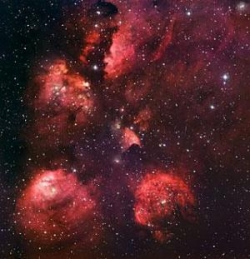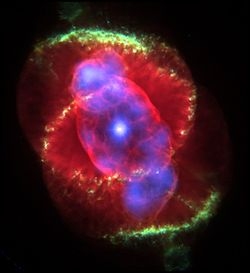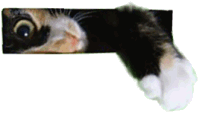KYC Tabloid special exclusive - shocking discovery highlights evidence of giant space cats!

You may think your cat is a star, but what about a cat that is more massive than a whole cloud of stars? That's astronomical object NGC 6334, a nebula of gas, interstellar dust and new-born stars that lies near the heart of the galaxy. Astronomers have given this nebula the informal name of the Cat's Paw Nebula because it looks as though an inconceivably large cat has tracked a massive pawprint across the void of outer space, rather as a domestic moggy might track muddy pawprints across the living room carpet.
From the paw-print we can tell that Felis Gigantica Interstellaris is somewhat different from the terrestrial breed. For a start, there are only three toes instead of the usual four (which has led to some spoilsports calling it the Bear Claw Nebula), and the claws appear to be retracted - possibly to avoid causing any rips in the space-time continuum. Scientists say that ripping the space-time continuum might be done by Felis Gigantica Interstellaris in much the same way that Felis Felis Domesticus shreds living-room curtains, but with much more dramatic effects. The 'palm' of the paw in the pawprint is much smaller as well, but this could be lifted on this particular pawprint, as after all, stepping on a hot cloud of proto-stars might well be a painful experience. There are stars in the nebula that are ten times larger than the sun, and they are all hot young 'blue stars' of less than a billion years old.
Anyone with a large observatory in their back garden who might want to take a look at this celestial pawprint should point their telescope at the constellation of Scorpius - the Scorpion - and set the focus to about 5500 light years away. It's not hard to spot the nebula which is about 50 light years across, but the focus is never completely clear because there are several large dust clouds in the way. The thesis that these dust clouds have been raised by Felis Gigantica Interstellaris using the hidden 'dark matter' of the universe as kitty litter remains an unproven speculation.

It should also be noted that 5500 light years is not too far for a space cat that might like to play with the earth as though it were a shiny blue bouncy ball. And since leaving the footprint near the heart of the galaxy Felis Gigantica Interstellaris has indeed got about 2000 light years closer to earth. Fortunately it has not moved since 1786, when astronomer William Herschel spotted the Cat's Eye nebula staring at the earth from the constellation of Draco 3300 light years away. The Cat's Eye is made of hot gasses, with a single bright point of the same magnitude as the Earth's star in the centre.
As the evidence for Felis Gigantica Interstellaris continues to mount, the question is why this gigantic creature is stationary. Because the rest of the cat is black - obviously - with fur that deflects radio waves, it is yet to be determined whether the star moggy is merely doing the old feline trick of snoozing with one eye open, or if it is in fact crouched patiently in front of a black (mouse)hole.

